中考英语专题复习:并列句和复合句 课件(17张PPT)
文档属性
| 名称 | 中考英语专题复习:并列句和复合句 课件(17张PPT) | 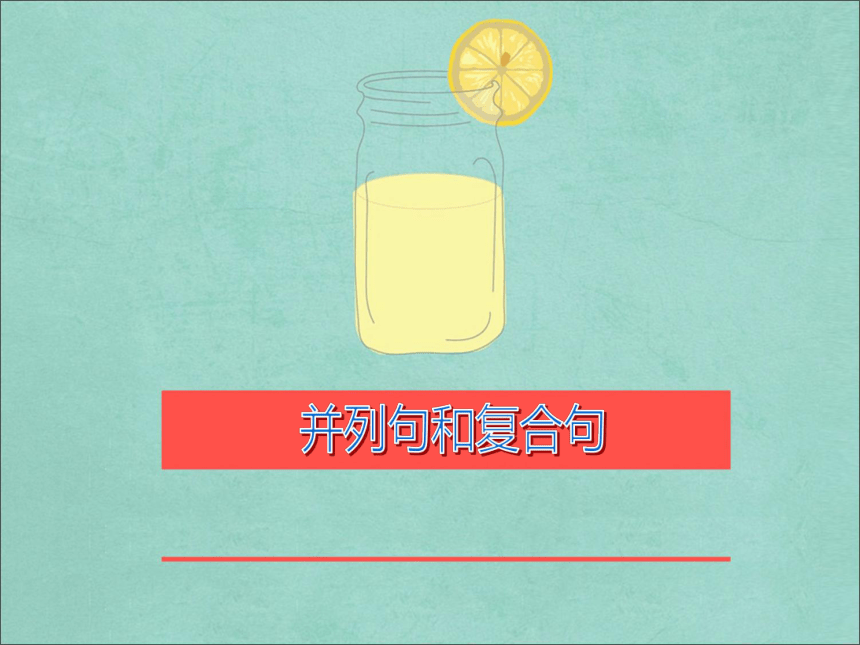 | |
| 格式 | zip | ||
| 文件大小 | 522.7KB | ||
| 资源类型 | 教案 | ||
| 版本资源 | 通用版 | ||
| 科目 | 英语 | ||
| 更新时间 | 2018-11-04 11:00:01 | ||
图片预览

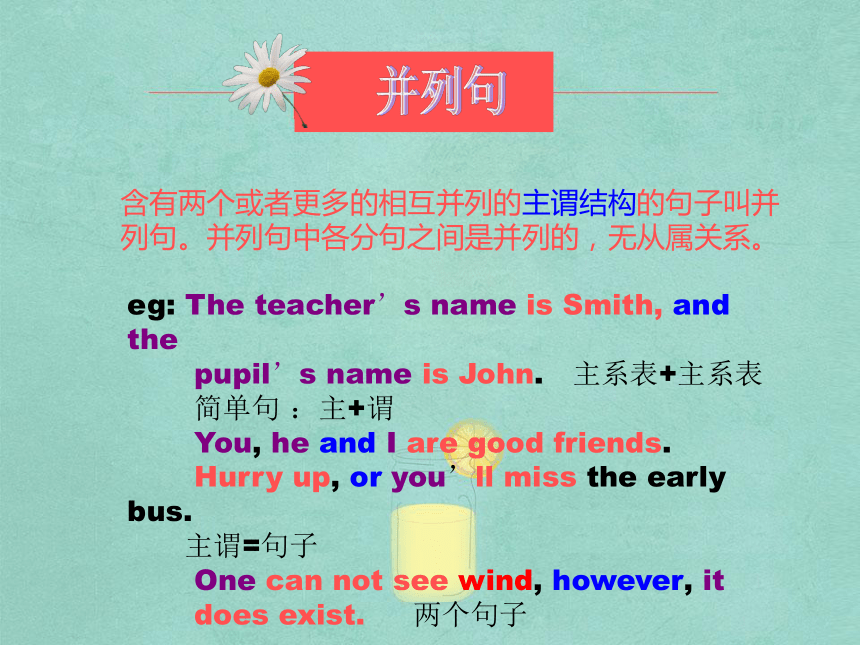


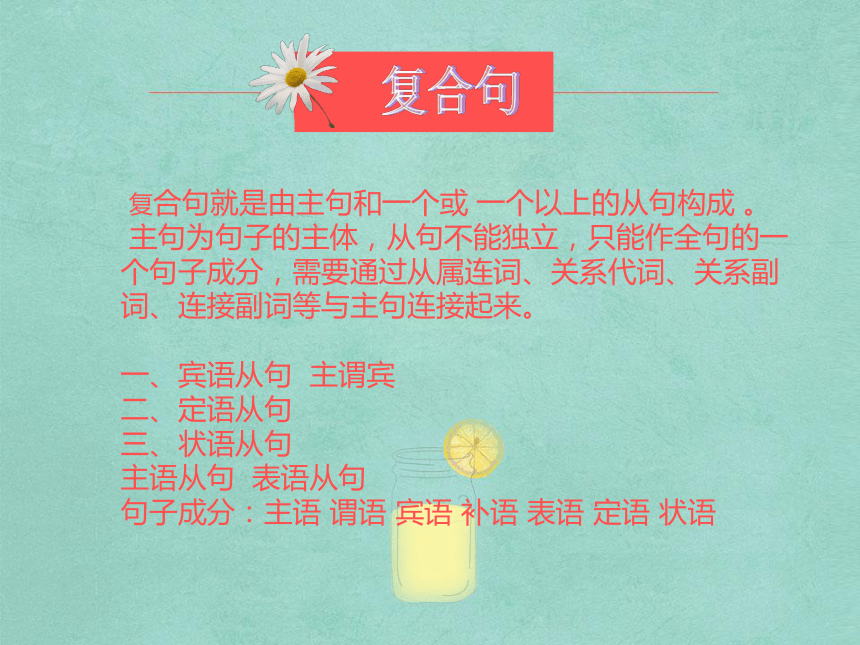
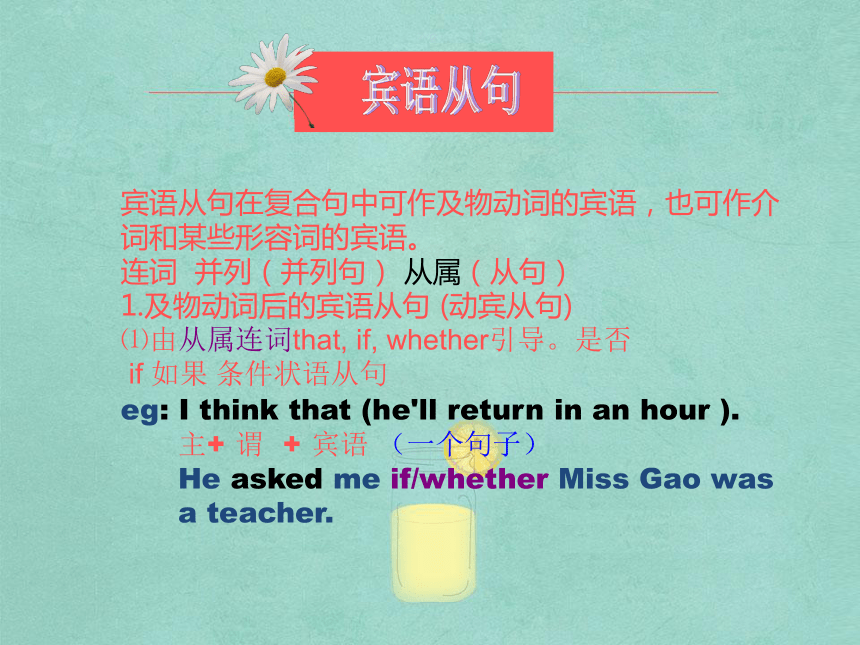
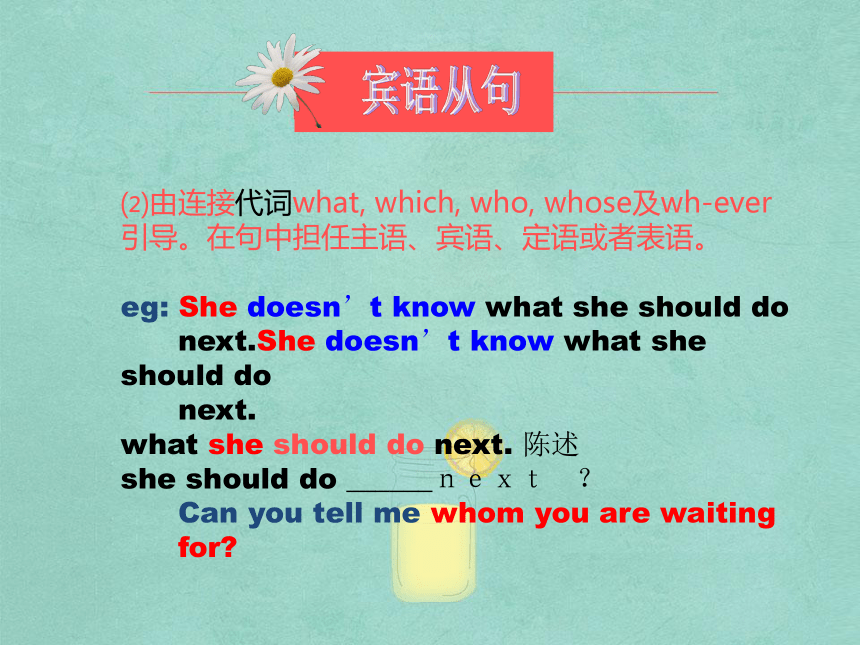
文档简介
课件17张PPT。并列句和复合句含有两个或者更多的相互并列的主谓结构的句子叫并列句。并列句中各分句之间是并列的,无从属关系。
并列句eg: The teacher’s name is Smith, and the
pupil’s name is John. 主系表+主系表
简单句 :主+谓
You, he and I are good friends.
Hurry up, or you’ll miss the early bus.
主谓=句子
One can not see wind, however, it
does exist. 两个句子 ①and连接两个或两个以上的句子成分时,不构成并
列句。
eg:You, she and I are all students. 简单句
其他用法②both…and, neither…nor连接两个句子成分时,
仍属于简单句。
eg:Both he and I like English.
Martin studies neither English nor
Spanish.
并列句不一定用并列连词构成,有时可能用逗号或分号说明两个分句之间的意义为并列关系。
eg:The moon went down; the stars grew
pale; the cold day broke; the sun rose.
Hurry up, it’s getting late.
不含并列连词的并列句 复合句就是由主句和一个或 一个以上的从句构成 。
主句为句子的主体,从句不能独立,只能作全句的一个句子成分,需要通过从属连词、关系代词、关系副词、连接副词等与主句连接起来。
一、宾语从句 主谓宾
二、定语从句
三、状语从句
主语从句 表语从句
句子成分:主语 谓语 宾语 补语 表语 定语 状语
复合句宾语从句在复合句中可作及物动词的宾语,也可作介词和某些形容词的宾语。
连词 并列(并列句) 从属(从句)
1.及物动词后的宾语从句 (动宾从句)
⑴由从属连词that, if, whether引导。是否
if 如果 条件状语从句
eg: I think that (he'll return in an hour ).
主+ 谓 + 宾语 (一个句子)
He asked me if/whether Miss Gao was
a teacher.
宾语从句⑵由连接代词what, which, who, whose及wh-ever引导。在句中担任主语、宾语、定语或者表语。
eg: She doesn’t know what she should do
next.She doesn’t know what she should do
next.
what she should do next. 陈述
she should do ______next ?
Can you tell me whom you are waiting
for?
宾语从句⑶由连接副词why, where, when, how引导, 在句中担任状语的成分。
eg:Could you tell me when the train will
leave?
Do you remember how he came?
主+ 谓语 +宾语
时态 语序 引导词
宾语从句(4)介词后面的宾语从句(介宾从句)
eg: Alice is sorry for what she said.
She always thinks of how she can
improve her spoken English.
宾语从句⑸某些形容词后的宾语从句
eg: I am glad that you can join us.
I am sorry (that) I am late.
宾语从句2.引导词it代表宾语从句
在“及物动词+宾语+宾语补足语”结构中,为了平衡句子结构,常用it作形式宾语,而将真正的宾语从句置于宾语补足语的后面。
It is +adj.+for/of sb. +to do....形式主语
eg: I think it necessary (that we should do
more practice in English learning).
it=that we should do more practice in
English learning 真正的宾语
宾语从句3. 宾语从句的语序
宾语从句必须是陈述语序,即按照主语+谓语的顺序。
eg: He asked me what I did yesterday
afternoon.
Do you know why winter is colder than
summer.
宾语从句4. 宾语从句的时态
(1)当主句中谓语是现在或将来时态时,从句中谓语不受主句谓语时态的影响,可以按需要使用任何时态。
eg: I hear (that) he'll be back in a few days. 主:一般现在时态 从 : 一般将来
I hear he came back a few days ago.
主:一般现在 从 : 一般过去
宾语从句(2) 当主句谓语是过去时态时,从句中的时态一般为表示过去的某种时态,以便保持与主句谓语动词时态的一致。
eg: She said she was much better than before.
主:过去时 从 :一般过去
She said she was reading a story book at
seven yesterday.
主:一般过去 从 :过去进行
He told me that he would take good care of
the baby.
主:过去 从句:过去将来
She said they had seen this film several
times. 主:过去 从 :过去完成
宾语从句5. 否定转移
在主从复合句中,当主句的主语谓第一人称,谓语动词是think、believe、suppose等时,要将从句的否定词转移到主句中,即主句的谓语动词用否定式,而从句的谓语动词用肯定式。
eg: I don't think he will come with you.
I don’t think you are right.
宾语从句6.宾语从句的简化
(1) 当宾语从句的主语和主句的主语相同,且主句的谓语动词是hope, wish, decide, agree, choose等时,从句可简化为不定式结构。
eg: I hope that I can receive your e-mail.
=I hope to receive your e-mail.
宾语从句(2) 当宾语从句的主语和主句的主语相同,且主句的谓语动词是know, remember, forget, learn等时,从句可简化为"疑问词+不定式"结构。
eg: She doesn't know what she should do
next.
= She doesn't know what to do next.
宾语从句
并列句eg: The teacher’s name is Smith, and the
pupil’s name is John. 主系表+主系表
简单句 :主+谓
You, he and I are good friends.
Hurry up, or you’ll miss the early bus.
主谓=句子
One can not see wind, however, it
does exist. 两个句子 ①and连接两个或两个以上的句子成分时,不构成并
列句。
eg:You, she and I are all students. 简单句
其他用法②both…and, neither…nor连接两个句子成分时,
仍属于简单句。
eg:Both he and I like English.
Martin studies neither English nor
Spanish.
并列句不一定用并列连词构成,有时可能用逗号或分号说明两个分句之间的意义为并列关系。
eg:The moon went down; the stars grew
pale; the cold day broke; the sun rose.
Hurry up, it’s getting late.
不含并列连词的并列句 复合句就是由主句和一个或 一个以上的从句构成 。
主句为句子的主体,从句不能独立,只能作全句的一个句子成分,需要通过从属连词、关系代词、关系副词、连接副词等与主句连接起来。
一、宾语从句 主谓宾
二、定语从句
三、状语从句
主语从句 表语从句
句子成分:主语 谓语 宾语 补语 表语 定语 状语
复合句宾语从句在复合句中可作及物动词的宾语,也可作介词和某些形容词的宾语。
连词 并列(并列句) 从属(从句)
1.及物动词后的宾语从句 (动宾从句)
⑴由从属连词that, if, whether引导。是否
if 如果 条件状语从句
eg: I think that (he'll return in an hour ).
主+ 谓 + 宾语 (一个句子)
He asked me if/whether Miss Gao was
a teacher.
宾语从句⑵由连接代词what, which, who, whose及wh-ever引导。在句中担任主语、宾语、定语或者表语。
eg: She doesn’t know what she should do
next.She doesn’t know what she should do
next.
what she should do next. 陈述
she should do ______next ?
Can you tell me whom you are waiting
for?
宾语从句⑶由连接副词why, where, when, how引导, 在句中担任状语的成分。
eg:Could you tell me when the train will
leave?
Do you remember how he came?
主+ 谓语 +宾语
时态 语序 引导词
宾语从句(4)介词后面的宾语从句(介宾从句)
eg: Alice is sorry for what she said.
She always thinks of how she can
improve her spoken English.
宾语从句⑸某些形容词后的宾语从句
eg: I am glad that you can join us.
I am sorry (that) I am late.
宾语从句2.引导词it代表宾语从句
在“及物动词+宾语+宾语补足语”结构中,为了平衡句子结构,常用it作形式宾语,而将真正的宾语从句置于宾语补足语的后面。
It is +adj.+for/of sb. +to do....形式主语
eg: I think it necessary (that we should do
more practice in English learning).
it=that we should do more practice in
English learning 真正的宾语
宾语从句3. 宾语从句的语序
宾语从句必须是陈述语序,即按照主语+谓语的顺序。
eg: He asked me what I did yesterday
afternoon.
Do you know why winter is colder than
summer.
宾语从句4. 宾语从句的时态
(1)当主句中谓语是现在或将来时态时,从句中谓语不受主句谓语时态的影响,可以按需要使用任何时态。
eg: I hear (that) he'll be back in a few days. 主:一般现在时态 从 : 一般将来
I hear he came back a few days ago.
主:一般现在 从 : 一般过去
宾语从句(2) 当主句谓语是过去时态时,从句中的时态一般为表示过去的某种时态,以便保持与主句谓语动词时态的一致。
eg: She said she was much better than before.
主:过去时 从 :一般过去
She said she was reading a story book at
seven yesterday.
主:一般过去 从 :过去进行
He told me that he would take good care of
the baby.
主:过去 从句:过去将来
She said they had seen this film several
times. 主:过去 从 :过去完成
宾语从句5. 否定转移
在主从复合句中,当主句的主语谓第一人称,谓语动词是think、believe、suppose等时,要将从句的否定词转移到主句中,即主句的谓语动词用否定式,而从句的谓语动词用肯定式。
eg: I don't think he will come with you.
I don’t think you are right.
宾语从句6.宾语从句的简化
(1) 当宾语从句的主语和主句的主语相同,且主句的谓语动词是hope, wish, decide, agree, choose等时,从句可简化为不定式结构。
eg: I hope that I can receive your e-mail.
=I hope to receive your e-mail.
宾语从句(2) 当宾语从句的主语和主句的主语相同,且主句的谓语动词是know, remember, forget, learn等时,从句可简化为"疑问词+不定式"结构。
eg: She doesn't know what she should do
next.
= She doesn't know what to do next.
宾语从句
同课章节目录
- 词法
- 名词
- 动词和动词短语
- 动词语态
- 动词时态
- 助动词和情态动词
- 非谓语动词
- 冠词
- 代词
- 数词和量词
- 形容词副词及其比较等级
- 介词和介词短语
- 连词和感叹词
- 构词法
- 相似、相近词比较
- 句法
- 陈述句
- 一般疑问句和否定疑问句
- 特殊疑问句及选择疑问句
- 反意疑问句
- 存在句(There be句型)
- 宾语从句
- 定语从句
- 状语从句
- 主谓一致问题
- 简单句
- 并列句
- 复合句
- 主谓一致
- 主、表语从句
- 名词性从句
- 直接引语和间接引语
- 虚拟语气
- 感叹句
- 强调句
- 倒装句
- 祈使句
- 句子的成分
- 句子的分类
- 题型专区
- 单项选择部分
- 易错题
- 完形填空
- 阅读理解
- 词汇练习
- 听说训练
- 句型转换
- 补全对话
- 短文改错
- 翻译
- 书面表达
- 任务型阅读
- 语法填空
- 其他资料
